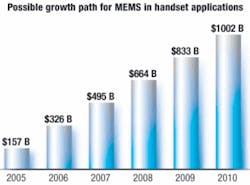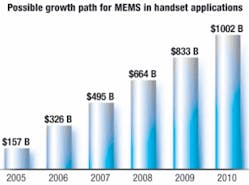Spending for microelectromechanical systems (MEMS) in mobile handsets reached $157 million in 2005, and will exceed $1 billion by 2010, predict analysts at In-Stat in Scottsdale, Ariz.
In addition to the microphones and bulk acoustic resonators that have dominated the MEMS market to date, there are emerging opportunities for inertial sensors principally in accelerometers, as well as in several types of RF components including band/mode switches, matching elements like digital varactors, and oscillators, analysts say.
“Although high-volume MEMS, such as microphones and bulk acoustic resonators, are cost competitive, there are no near-term opportunities for other types of MEMS to break into the mobile handset market based on price advantage,” says In-Stat analyst Frank Dickson.
“Longer term, displays, fuel cells, and other types of MEMS devices could also develop a price advantage,” Dickson says. “However, suppliers of these devices may find a quicker path to profit in other markets that have less demanding cost and size requirements.”
Mobile handsets, which are the largest product market for semiconductors outside the personal computer market, are also a major opportunity for MEMS component suppliers, analysts say. MEMS mode/band switches and digital tuning will first appear in mobile handsets in 2007, followed by MEMS-based oscillators in the following year.
In the microphone area, continued growth is foreseen based upon an increasing demand for ultrathin handsets, as well as continuing price declines.
The research is in the report “MEMS-Making Their Mark in Mobile Handsets” (IN0603148ESCA). It covers the intersection of mobile handsets and MEMS, and includes forecasts of MEMS handset components through 2010. It also analyzes how current MEMS applications will grow; where and why MEMS devices can replace other types of components; and what new features MEMS can enable.
This research is part of In-Stat’s Emerging Semiconductor Chips & Applications Service, which focuses on the new or changing critical semiconductor applications and technologies that could change the dynamics of the semiconductor industry and drive future demand.
For more information on this research, contact In-Stat online at www.in-stat.com.




